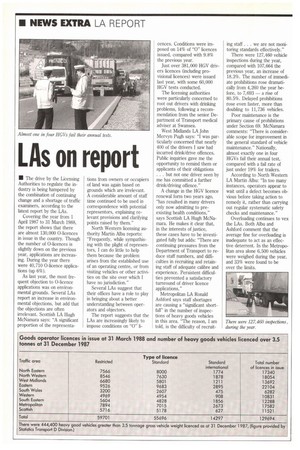Lk on report
Page 12

If you've noticed an error in this article please click here to report it so we can fix it.
• The drive by the Licensing Authorities to regulate the industry is being hampered by the combination of continuing change and a shortage of traffic examiners, according to the latest report by the LAs.
Covering the year from 1 April 1987 to 31 March 1988, the report shows that there are almost 130,000 0-licences in issue in the country. Though the number of 0-licences is slightly down on the previous year, applications are increasing. During the year there were 40,710 0-licence applications (up 6%).
As last year, the most frequent objection to 0-licence applications was on environmental grounds. Several LAs report an increase in environmental objections, but add that the objections are often irrelevant. Scottish LA Hugh McNamara says: "A significant proportion of the representa
tions from owners or occupiers of land was again based on grounds which are irrelevant. A considerable amount of staff time continued to be used in correspondence with potential representors, explaining relevant provisions and clarifying points raised by them."
North Western licensing authority Martin Albu reports: "Frequently, while sympathising with the plight of representors, I can do little to help them because the problem arises from the established use of an operating centre, or from visiting vehicles or other activities on the site over which I have no jurisdiction."
Several LAs suggest that their offices have a role to play in bringing about a better understanding between operators and objectors.
The report suggests that the LAs are increasingly likely to impose conditions on "0" li
cences. Conditions were imposed on 14% of "0" licences issued, compared with 9.8% the previous year.
Just over 381,000 HGV drivers licences (including provisional licences) were issued last year, with some 60,000 HGV tests conducted.
The licensing authorities were particularly concerned to root out drivers with drinking problems, following a recommendation from the senior Department of Transport medical adviser at Swansea.
West Midlands LA John Mervyn Pugh says: "I was particularly concerned that nearly 400 of the drivers I saw had incurred drink/drive offences. Public inquiries gave me the opportunity to remind them or applicants of their obligations . . . but not one driver seen by me has committed a further drink/driving offence."
A change in the HGV licence renewal form two years ago, "has resulted in many drivers only now admitting to preexisting health conditions," says Scottish LA Hugh McNamara. He makes it clear that, in the interests of justice, these cases have to be investigated fully but adds: "There are continuing pressures from the Department of Transport to reduce staff numbers, and difficulties in recruiting and retaining staff of adequate calibre and experience. Persistent difficulties prevented a satisfactory turnround of driver licence applications."
Metropolitan LA Ronald Ashford says staff shortages are causing a "significant shortfall" in the number of inspections of heavy goods vehicles in this area. "The reason, I am told, is the difficulty of recruit
ing staff. . . we are not monitoring standards effectively."
There were 127,460 vehicle inspections during the year, compared with 107,664 the previous year, an increase of 18.3%. The number of immediate prohibitions rose dramatically from 4,260 the year before, to 7,693 — a rise of 80.5%. Delayed prohibitions rose even faster, more than doubling to 11,736 vehicles.
Poor maintenance is the primary cause of prohibitions under Section 69. McNamara comments: "There is considerable scope for improvement in the general standard of vehicle maintenance." Nationally, almost exactly one in four HGVs fail their annual test, compared with a fail rate of just under 19% for trailers.
According to North Western LA Martin Albu: "In too many instances, operators appear to wait until a defect becomes obvious before taking action to remedy it, rather than carrying out regular systematic safety checks and maintenance."
Overloading continues to vex the LAs. Both Albu and Ashford comment that the average fine for overloading is inadequate to act as an effective deterrent. In the Metropolitan area alone 6,500 vehicles were weighed during the year, and 33% were found to be over the limits.
































































































































